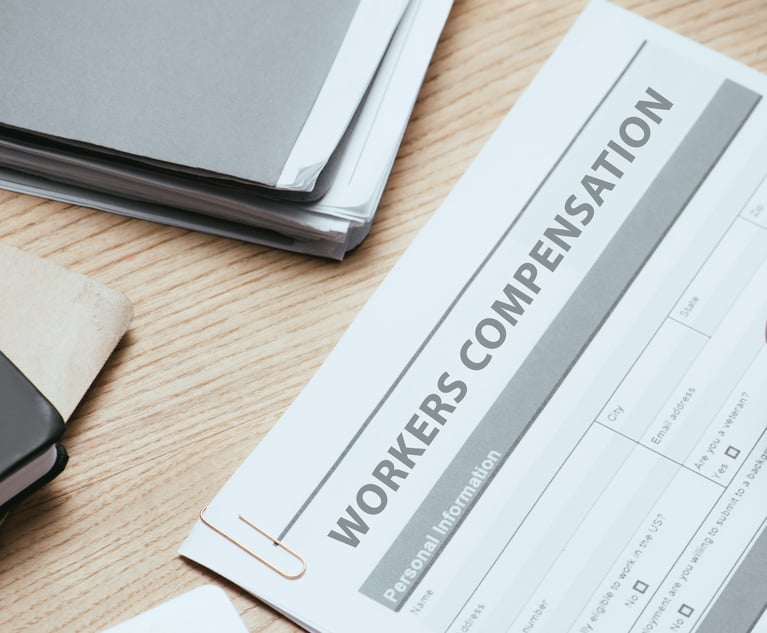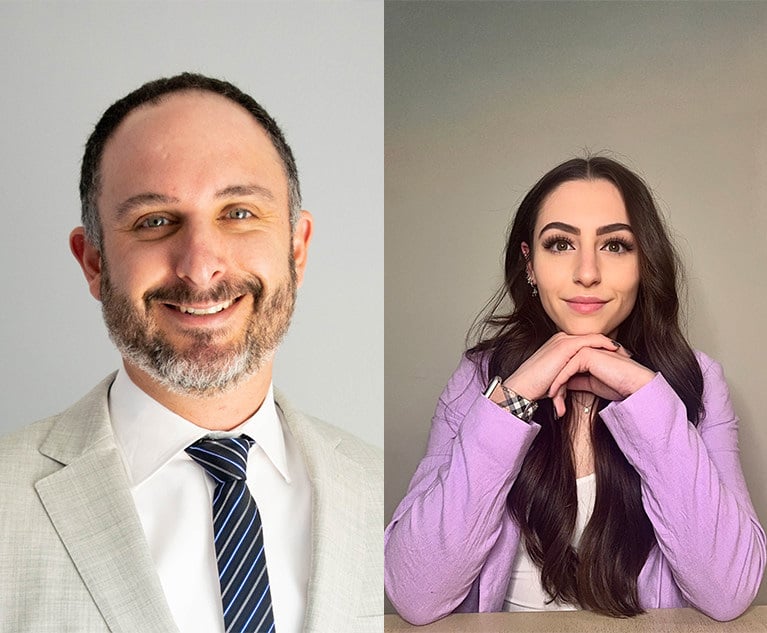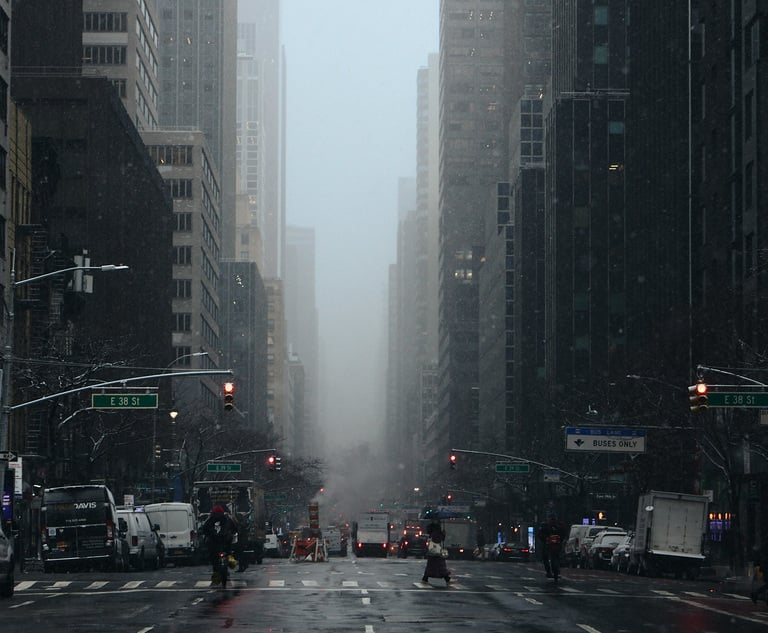Workers' Comp Board Clarifies Scope of COVID-19 Compensability
As employers in New York begin to reopen, employee infection events are likely to occur. Employers should understand the potential applicability of workers' compensation coverage to guard against unexpected tort and other liability.
July 17, 2020 at 10:35 AM
8 minute read
 (Photo: Diego M. Radzinschi/ALM)
(Photo: Diego M. Radzinschi/ALM)
As employers throughout New York resume in-person operations, they must also contend with COVID-19's continuing presence as a risk to their workforce. While the virus's transmission in New York has steadily declined since its April 2020 peak, ongoing levels of infection will persist until an effective treatment or vaccine is widely available. For many employers in the state, and particularly those operating workplaces where social distancing measures are difficult to maintain, employee infection in the workplace may be less of a possibility than an inevitability.
This reality has sparked an increased focus on the scope of the workers' compensation system in New York, which provides cash and medical benefits to qualifying employees who become injured or ill in the course of employment. While workers' compensation requires employers to cover benefits provided to eligible employees without regard to fault, the system also offers the advantage of providing the same employees' exclusive remedy, barring a subsequent civil action (the "workers' compensation bar"). The question of whether COVID-19 qualifies as a compensable illness consequently affects whether New York employers could be subject to increased workers' compensation premiums, litigation risk or both.
In response to increasing questions from both employers and employees, the New York Workers' Compensation Board (the board) recently issued new guidance (the guidance) shedding light on whether employees who contract COVID-19 in the workplace may be eligible for workers' compensation benefits.
Though the guidance is designed to address a new and rapidly evolving pandemic, it draws upon and is consistent with principles established by New York courts addressing the compensability of other communicable diseases, such as tuberculosis, HIV and hepatitis.
This article examines both the board's new guidance and relevant historical interpretations of the New York Workers' Compensation Law (NYCWL), and provides key takeaways to New York employers who may face an increasing number of COVID-19-related workers' compensation claims.
"Occupational Disease"
New York, unlike some other states, has not codified a presumption or entitlement to workers' compensation benefits for employees who contract COVID-19 in the workplace.
Instead, under the NYWCL, an employee who contracts COVID-19 or another illness at work is only eligible for benefits if the sickness qualifies as an "occupational disease." N.Y. Work. Comp. L. §§37-48. Certain diseases, including lead poisoning, occupational cancers and respiratory diseases linked to silica or coal dust automatically qualify as compensable occupational diseases. N.Y. Work. Comp. L. §§3, 39.
The definition further includes a "catch-all" category that encompasses any "disease or infection [that] may naturally and unavoidably" arise out of or in the course of an employee's employment. N.Y. Work. Comp. L. §§2, 48. However, for illnesses to fall into this unspecified category, the affected employee must show a direct connection between the disease and the nature of his or her employment, as opposed to some condition in the workplace or ordinary contact with co-workers.
The Guidance
On June 7, 2020, the board released the guidance with the goal of providing clarity regarding whether COVID-19 is a compensable illness. N.Y. Workers' Comp. Bd., COVID-19 & Workers' Compensation Q&A (June 7, 2020), available at http://www.wcb.ny.gov/content/main/TheBoard/covid-19-workers-compensation-q-a-june-2020.pdf. While the board did not implement a "bright line" rule or test for compensability, it specified that employees who contract the virus while "working closely with the public in locations where COVID-19 exposure is documented" are more likely to qualify for workers' compensation benefits.
The board provided examples of certain categories of employees who might be eligible for benefits by virtue of such exposure, including predictable groups like health care workers and first responders. Notably, however, the list also includes groups of employees who interact with the public outside of a medical setting, such as transportation, food service and retail workers. Regardless of occupation, the guidance makes clear that all claimants bear the burden of both demonstrating a "significantly elevated risk in [the] workplace" and producing a medical report from an authorized workers' compensation physician connecting their employment to their infection before they may recover benefits. Id.
Relevant New York Court Decisions
Although the guidance deals with a novel virus, the board's interpretation is consistent with New York court decisions evaluating workers' compensation claims arising from outbreaks of other types of communicable disease. As these cases make clear, these infections only qualify as compensable "occupational diseases" under the NYWCL if the nature of an employee's work placed the employee at a high risk of exposure.
For instance, in Lyden v. United Hospital, 275 A.D. 877 (N.Y. App. Div. 3d Dep't 1949), a laboratory technician's tuberculosis qualified as a compensable occupational disease where the technician did not have tuberculosis before beginning the job and had no contact with anyone diagnosed with tuberculosis outside of the workplace. Similarly, in Esposito v. N.Y.S. Willowbrook School, 46 A.D.2d 969 (N.Y. App. Div. 3d Dep't 1974), a kitchen worker at a school suffering from a hepatitis outbreak was entitled to workers' compensation benefits after he contracted the disease handling contaminated student food waste. And in Lachowicz v. Albany Medical Center Hospital, 30 A.D.2d 1004 (N.Y. App. Div. 3d Dep't 1968), a maintenance worker in a tuberculosis ward was deemed entitled to workers' compensation benefits after he contracted the disease, even though there was no evidence that he came into direct contact with a patient diagnosed with tuberculosis, because he repaired items in the same location.
By contrast, even employees who can prove that they contracted a communicable disease at work still may not qualify for benefits if the nature of their work did not place them at increased risk. In Paider v. Park East Movers, 19 N.Y.2d 373 (1967), for example, a moving company truck driver who contracted tuberculosis from an infected co-worker was denied benefits because his illness resulted from "ordinary contact with a fellow employee," rather than any "distinctive feature of the kind of work performed."
Likewise, in Artiste v. Kingsbrook Jewish Medical Center, 221 A.D.2d 81 (N.Y. App. Div. 3d Dep't 1996), the court held that a nurse's aide who contracted HIV through an accidental needle stick from a diabetic patient with no signs of HIV did not have a compensable occupational disease, as her job duties did not involve contact with known HIV-positive patients or contaminated blood products.
Key Takeaways
In the COVID-19 context, both the board's guidance and the jurisprudence outlined above reinforce limitations on when the virus may qualify as a compensable occupational disease. Even employees in the categories flagged by the board must still clear the hurdle of demonstrating a connection between the nature of their workplace and their own infection before they can recover benefits. While this may be a simple proposition for health care workers with continued exposure to COVID-19 patients, the path is less clear for other employees, including those who have regular contact with the public.
The odds that an infected employee may be deemed eligible for workers' compensation benefits is perhaps best envisioned as a spectrum, taking into account factors such as the level of exposure to the public, the number of COVID-19 infections in the area, and the location of the work (e.g. indoors or outdoors, large or small space, highly trafficked or less patronized).
For instance, a retail employee who contracts COVID-19 while working at a busy indoor store in an area with a high rate of infection may have a compensable claim, while a food service worker who contracts the virus while working in a takeout restaurant in a less-affected region may not. Applying the same principles, office workers with little public contact seem less likely to demonstrate that their case of COVID-19 is a compensable occupational disease under the NYWCL. This is particularly so if the employee became ill from incidental exposure to the virus, such as through ordinary contact with an infected co-worker.
On the far end of the spectrum are telecommuting employees, whose home may be treated as the "workplace" under the NYWCL when the employee regularly works there for the employer's benefit and with the employer's knowledge. Telecommuting employees are very unlikely to qualify for workers' compensation benefits if they contract COVID-19, as the nature of their work entails no heightened exposure to the virus at all.
Conclusion
In sum, any inquiry into a New York employee's eligibility for workers' compensation necessarily requires examination of the facts and circumstances of that worker's employment. New York employers should keep the foregoing principles in mind when evaluating, among other things, whether to pay or contest claims. Employers may also wish to consider how these principles may apply to evaluate the likelihood that they can take advantage of the workers' compensation bar for COVID-19 claims and project future litigation risk. Ultimately, however, an employer's best protection against COVID-19-related workplace claims remains adherence to federal, state and local guidelines regarding reducing the spread of the virus, alongside careful, deliberate implementation of return-to-work strategies.
Brian Murphy is a partner and Lindsay Stone is an associate in the labor and employment practice at Sheppard, Mullin, Richter & Hampton.
This content has been archived. It is available through our partners, LexisNexis® and Bloomberg Law.
To view this content, please continue to their sites.
Not a Lexis Subscriber?
Subscribe Now
Not a Bloomberg Law Subscriber?
Subscribe Now
NOT FOR REPRINT
© 2025 ALM Global, LLC, All Rights Reserved. Request academic re-use from www.copyright.com. All other uses, submit a request to [email protected]. For more information visit Asset & Logo Licensing.
You Might Like
View All



New York State Authorizes Stand-Alone Business Interruption Insurance Policies
6 minute readLaw Firms Mentioned
Trending Stories
- 1States Accuse Trump of Thwarting Court's Funding Restoration Order
- 2Microsoft Becomes Latest Tech Company to Face Claims of Stealing Marketing Commissions From Influencers
- 3Coral Gables Attorney Busted for Stalking Lawyer
- 4Trump's DOJ Delays Releasing Jan. 6 FBI Agents List Under Consent Order
- 5Securities Report Says That 2024 Settlements Passed a Total of $5.2B
Who Got The Work
J. Brugh Lower of Gibbons has entered an appearance for industrial equipment supplier Devco Corporation in a pending trademark infringement lawsuit. The suit, accusing the defendant of selling knock-off Graco products, was filed Dec. 18 in New Jersey District Court by Rivkin Radler on behalf of Graco Inc. and Graco Minnesota. The case, assigned to U.S. District Judge Zahid N. Quraishi, is 3:24-cv-11294, Graco Inc. et al v. Devco Corporation.
Who Got The Work
Rebecca Maller-Stein and Kent A. Yalowitz of Arnold & Porter Kaye Scholer have entered their appearances for Hanaco Venture Capital and its executives, Lior Prosor and David Frankel, in a pending securities lawsuit. The action, filed on Dec. 24 in New York Southern District Court by Zell, Aron & Co. on behalf of Goldeneye Advisors, accuses the defendants of negligently and fraudulently managing the plaintiff's $1 million investment. The case, assigned to U.S. District Judge Vernon S. Broderick, is 1:24-cv-09918, Goldeneye Advisors, LLC v. Hanaco Venture Capital, Ltd. et al.
Who Got The Work
Attorneys from A&O Shearman has stepped in as defense counsel for Toronto-Dominion Bank and other defendants in a pending securities class action. The suit, filed Dec. 11 in New York Southern District Court by Bleichmar Fonti & Auld, accuses the defendants of concealing the bank's 'pervasive' deficiencies in regards to its compliance with the Bank Secrecy Act and the quality of its anti-money laundering controls. The case, assigned to U.S. District Judge Arun Subramanian, is 1:24-cv-09445, Gonzalez v. The Toronto-Dominion Bank et al.
Who Got The Work
Crown Castle International, a Pennsylvania company providing shared communications infrastructure, has turned to Luke D. Wolf of Gordon Rees Scully Mansukhani to fend off a pending breach-of-contract lawsuit. The court action, filed Nov. 25 in Michigan Eastern District Court by Hooper Hathaway PC on behalf of The Town Residences LLC, accuses Crown Castle of failing to transfer approximately $30,000 in utility payments from T-Mobile in breach of a roof-top lease and assignment agreement. The case, assigned to U.S. District Judge Susan K. Declercq, is 2:24-cv-13131, The Town Residences LLC v. T-Mobile US, Inc. et al.
Who Got The Work
Wilfred P. Coronato and Daniel M. Schwartz of McCarter & English have stepped in as defense counsel to Electrolux Home Products Inc. in a pending product liability lawsuit. The court action, filed Nov. 26 in New York Eastern District Court by Poulos Lopiccolo PC and Nagel Rice LLP on behalf of David Stern, alleges that the defendant's refrigerators’ drawers and shelving repeatedly break and fall apart within months after purchase. The case, assigned to U.S. District Judge Joan M. Azrack, is 2:24-cv-08204, Stern v. Electrolux Home Products, Inc.
Featured Firms
Law Offices of Gary Martin Hays & Associates, P.C.
(470) 294-1674
Law Offices of Mark E. Salomone
(857) 444-6468
Smith & Hassler
(713) 739-1250






